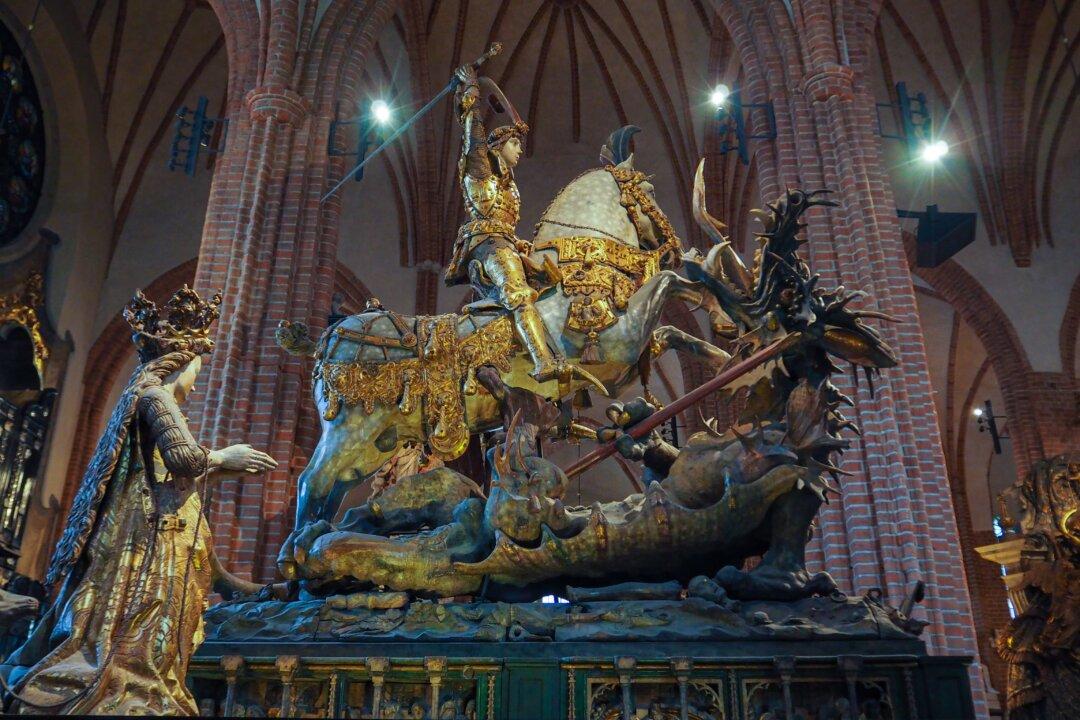Art experts remain baffled by a 16th-century altarpiece titled “The Virgin and Child With Saints Louis and Margaret.”
The National Gallery, London recently acquired the devotional work for 16.4 million pounds (around $21.7 million). The American Friends of the National Gallery, London helped fund the acquisition. Members of the public will be able to view the altarpiece for the first time in over 60 years, when the gallery displays it starting May 10. They’ll also learn some of the surprising elements in the work that explain why its artist remains a mystery.

The Altarpiece
The artist rendered an open-air chapel, with the king of France St. Louis, St. Margaret, and two angel musicians flanking the enthroned Virgin and Christ.The Virgin is full of grace. She’s dressed in red, symbolic of her humility and earthly presence. She gently holds a flower between her thumb and forefinger. Christ sits on her lap, toying with a goldfinch, a common pet in medieval times and an art motif symbolizing the goldfinch that plucked a thorn from Christ’s crown of thorns at Calvary.
St. Louis appears lifelike; it could almost be his portrait. He wears blue robes embroidered with gold fleur-de-lis emblems and the collar of the Order of St. Michael, a French dynastic order of chivalry.
The pious St. Margaret ascends from the stomach of the dragon, which swallowed her. Both her poise and opulent gown belies her terrifying ordeal. She holds a jewel-encrusted cross, perhaps symbolizing her faith and the sign of the cross she made that allowed her miraculous escape.
Delightful and Peculiar Details
The artist deftly rendered exquisite details: the double knots in St. Louis’s chain, the gems on St. Margaret’s cross, and the sunlight sweeping across her cheek.He also included unusual elements. The figures on St. Louis’s spectre may symbolize the Last Judgment, an odd theme for metalwork at the time. St. Margaret’s sequined hairnet, her daisy crown, and the bird are all unusual. The bird could refer to the bird that descended from heaven to crown Margaret in “The Golden Legend,” a collection of 153 hagiographies (biographies of saints) written by Italian chronicler and archbishop of Genoa Jacobus de Voragine between 1250 and 1280.
Understanding the Altarpiece
The altarpiece was first documented in 1602, in Drongen Abbey in Ghent, modern-day Belgium. It’s uncertain whether the altarpiece was commissioned for the abbey, but there are several striking connections: The monastery’s coat-of-arms include the fleur-de-lis and a swan (which is painted on the right pilaster). In addition, in 1608, the monks consecrated the abbey’s altar dedicated to the Virgin and St. Margaret.Experts believe a French or Netherlandish artist painted the work around 1510. They favor the Netherlandish artist attribution because the oak wood for the panel was sourced from the Baltic area; French artists preferred painting on local wood panels.
According to the gallery, “The panel’s overall eccentricity and the dramatically foreshortened faces of the saints and angels are reminiscent of the early work of Jan Gossaert (active 1508; died 1532). … The composition and versatile execution—alternating smoothly painted areas and minute details with more dynamic passages—also pay homage to the Netherlandish tradition of Jan van Eyck (active 1422; died 1441) and Hugo van der Goes (active 1467; died 1482). The overall sense of plasticity, monumentality, and the strong shadows recall the work of French painters like Jean Hey (Master of Moulins) (active 1482; died after 1504.)”
Whoever painted the altarpiece remains a mystery for now. For the art lovers and the faithful, it is, in all certainty, a glorious work of devotion.








